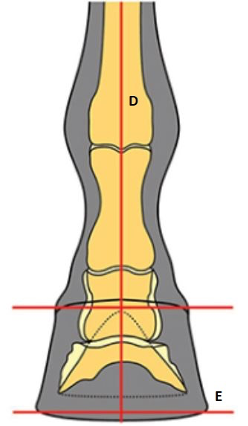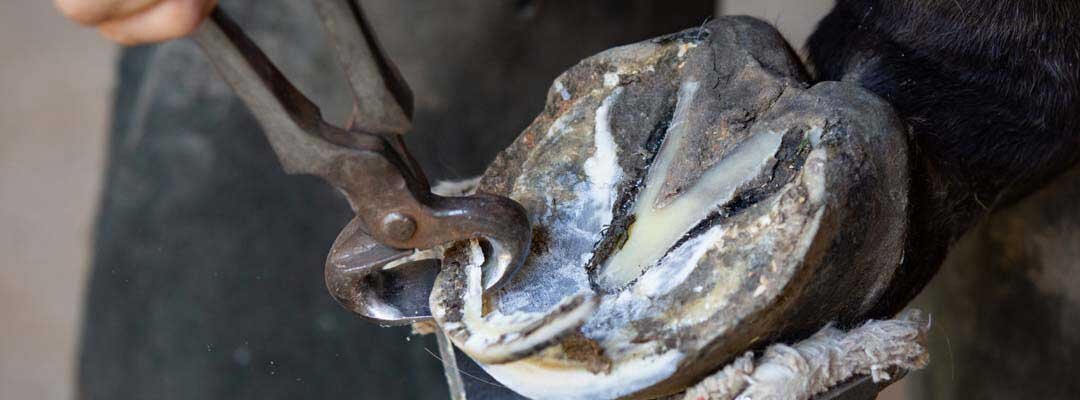There is an old adage that describes the horse as having 5 hearts, each as equally important as the others. The 5 hearts are made up of one actual heart and 4 feet. Of course, a horse cannot live without any of these 5 hearts, which underlines the importance of the foot to the horses’ life.
An entire textbook could be written about the equine foot, its ideal characteristics, as well as all of the problems that can happen within the foot. The purpose of this article will be to briefly discuss a few points on a very important subject: Foot Conformation. More specifically, we will discuss the hoof pastern axis (HPA), hoof balance, and heel conformation.
Before we begin, it should be mentioned that while the ideal foot characteristics are something to strive for, in reality, for some horses, it will not be possible. While the large majority of horses can achieve the ideal foot, there are many horses that will never achieve the ideal foot due to genetics, developmental problems, or injury. Some of these horses will function well despite poor foot conformation, while for others it will result in lameness and poor performance. The ideal foot should be a goal to work towards in our current horses, and to use as a standard when judging new horses for purchase and for use in new breeding prospects.
The first point of confirmation to mention is the hoof pastern axis. The hoof pastern axis (HPA) describes the alignment of the bones from the fetlock down to the foot (aka the distal limb, equine digit). This includes 3 bones, the first phalanx, the second phalanx, and the third phalanx (the coffin bone). In simple terms, the ideal alignment of these bones is in a straight line. More specifically, while looking at the foot from the side, it should be possible to draw a straight line through the middle of the bones, without any angles created at the joints.
To truly evaluate the HPA, a radiograph must be taken to adequately assess the alignment. However, there is an easy way to quickly check the alignment. First, place the horse’s foot such that the cannon bone is perpendicular to the ground. Then you must look at the foot straight from the side. Look at the front surface of the hoof, and the front surface of the pastern and imagine a line drawn to follow these surfaces. Ideally, the line should be straight, with no angles created. (Fig. 1, Line A) If there is an angle created that points down and backwards, there is a negative or broken-back HPA. If there is an angle pointing up and frontwards, there is a broken-forward HPA.
A broken-back HPA is the most common abnormality, but both it and the broken-forward HPA can negatively affect the comfort and performance of the horse. Essentially, the altered HPA can put extra strain on the tendons, ligaments, and soft tissue within the foot, leading to injury and pain. Furthermore, an abnormal axis can alter the break-over of the foot and the dynamics of the foot allowing for shock absorption and proper foot placement during the stride.
If you perform the simple test of checking your horse’s HPA, and find that it is abnormal, mention it to your farrier. It is also recommended that you have your veterinarian take x-rays to further evaluate the HPA. These radiographs are very useful to the veterinarian and farrier to guide further trimming and to make proper adjustments to correct the HPA.

Figure 1
The next point to mention is hoof balance. The ideal hoof balance first involves looking at the bottom of the foot (the sole). The length of the foot from front to back, should equal the width of the foot from side to side. (Fig. 2, Long red arrows) Furthermore, the distance from the side wall of the hoof to the point of the frog should be equal from side to side. (Fig. 2, Short red arrows) This is to say that the hoof should be symmetrical.

Figure 2
In addition, with the foot bearing weight on the ground look at the limb from the front, with the cannon bone perpendicular to the ground. The alignment of the limb should be straight through the middle of the cannon bone, down through the middle of the pastern and the hoof. (Fig. 3, Line D) Also, the ground bearing surface of the foot (Fig. 3, Line E) should be perpendicular to the line drawn down the middle (axis) of the limb. (Fig. 3, Line D) This alignment is most accurately evaluated with x-rays.

Figure 3
The last point to mention is heel conformation. Pick up your horses foot and look at the sole. The most caudal, or rear-most point of the hoof wall that contacts the ground at the heel of the foot should align with the base of the frog at its widest point. (Fig. 2, Line F) Now let your horse stand on the foot, and place the limb like you did to evaluate to the HPA. Looking from the side of the foot, take note of the rear most point of the heel hoof wall, where it contacts the ground. This point should line up with a line drawn down the centre of the cannon bone. (Fig. 1, Line B) This can be difficult to see, so you may need to get right down beside the foot to see where the heel contacts the ground at the rear most point. While you are beside the foot, look at the slope of the heel on the back of the foot. It should be parallel to the slope of the front of the hoof. (Fig. 1, Line C)
Although there are many different aspects to judging the conformation of the equine foot, the few that we have described in this article are very important. The parameters mentioned above describe the ideal foot. While not every horse can achieve this conformation, it is important to use these parameters to guide hoof trimming to transform and maintain our horses’ feet to as near to this ideal as possible. Maintaining ideal foot conformation will help our horses be as comfortable as possible and to function and perform at their highest level.
All figures adapted from images credited to Dr. Stephen O’Grady.
Written by Dr. Mackenzie Marks
Learn more about Dr. Mackenzie Marks here.


